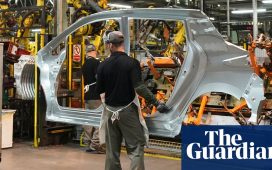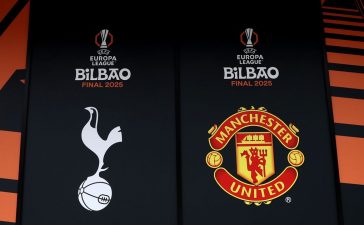While working in the family business is not an unusual career path, McKeel Hagerty found out that was to be his calling by a most unorthodox route. The 56-year-old CEO of Hagerty, a classic-car insurance company that has morphed into a leading purveyor of motoring experiences, was a self-described entrepreneur early on, but wanted to be a professor.
“My first business was an apple orchard here in Michigan,” says Hagerty, who later got a graduate degree at Saint Vladimir’s Orthodox Theological Seminary in New York. “I then went and started my doctoral work in ancient philosophy—about as far from apple orchards and insurance as you can get, but I draw on that stuff every day,” he says.

McKeel Hagerty helping with the family’s insurance business early on.
Hagerty
According to Hagerty, it was a break from his studies that truly enlightened him. “Anybody who’s worked in an entrepreneurial family knows that you do some kind of work in the family business, whether you like it or not,” says Hagerty. “I took a little pause from my doctoral studies, came back to help the family business, and fell in love with it. My parents always had this core idea that people take good care of their toys, and if you tap into that kind of emotion, it works. Take good care of the people who take good care of their toys.”
That mission statement has given McKeel a unique perspective on car culture in general and the collector community in particular. But the rise of his namesake company’s presence in that world, which includes the formation of Broad Arrow Auctions and the recent purchase of prominent automotive events, has raised a few eyebrows and garnered some critics. We recently asked McKeel about that growth, as well as the market trends he’s seeing, what he thinks might be the next holy-grail car, and his thoughts on the recent scheduling controversy around the Amelia concours and the new ModaMiami exhibition looking to compete.

A rare version of the 2021 Ford GT is put on the block at Amelia through Hagerty’s Broad Arrow Auctions.
Hagerty
In your opinion, what is the current health of the collector-car market?
It’s pretty healthy, but it’s turning generationally. The oldest car collectors, who have the best-of-the-best vehicles, are now downsizing, they’re not amassing collections like they used to because they’re getting older. Many of the auction companies are selling off some of these collections, so there are buying opportunities for the next generation to be able to experience great cars. If you were to compare 21-year-olds today with 21-year-olds from 1957, there was a bigger percentage of the earlier population that would have said, “I’m really into cars.” It’s probably a smaller percentage now, but the numbers are still very large because the generations are bigger. There are more than enough young people to keep the car world going, the challenge is that they’ve got to be able to make money.

A 1937 Alfa Romeo 8C 2900 B (left) and a 1965 Ford GT40 Mk I (right) won Best of Show in the Concours d’Elegance and Concours de Sport categories, respectively, at the 2023 Greenwich Concours.
Hagerty
You hear some say, “young people don’t like cars anymore,” but a lot of that came out of the financial crises in 2008 and 2009, when 25-year-olds didn’t have jobs and were moving home. But those people are now close to 40 years old, making six to seven figures, and can certainly afford to buy cool stuff. We see a strong level of interest with younger owners, and generally for cars that are a little bit newer. So [the collector-car market) is healthy, but it’s definitely changing.
What do you think will be the next Ferrari 250 GTO, the new holy-grail car from a collectibility standpoint?
The McLaren F1 ticks some of the similar boxes—limited production, there was a kind of cult of personality around Gordon Murray, and there was a motorsport element to it. Now there are a lot of other cars that go above their original sale price, you think about [Ferrari] F40s, F50s, and Enzos, Porsche 959s, but none of them had that [McLaren F1] order-of-magnitude jump. You could also look at the AMG One or Gordon Murray’s T.50—maybe lightning strikes Gordon Murray twice. There are going to be collectors of every Pagani, Koenigsegg, and Bugatti produced, but to go 25 to 30 times what they were originally sold for, that’s a pretty rare crowd. No matter what it is, it’s going to be a fast car and it’s going to be one that probably has some motorsport overlay.

A 1998 McLaren F1 “LM-Specification” supercar.
Steve Zak Photography/FilmMagic/Getty Images
Are we seeing a return to analog at the highest end of the automotive market?
The analog versus high-tech debate is a story that’s still being written. The collectibility of modern analog cars, by many standards, probably found its high-water mark with the McLaren F1, which Gordon Murray has said was specifically designed to be a remarkable performer but not to lean heavily into technology that could be outmoded. Then Singer [Vehicle Design] takes these great retro-looking [Porsche] 911s and gives them very modern performance, but using decidedly analog technology to make them go. I think they really struck a natural chord; from the way the gauges look to the way the engine is configured. I think that’s what’s appealed to a lot of people with many of these very boutique restorer/modifier brands.

The analog interior of a DLS-Turbo restoration project from Singer Vehicle Design.
Singer Vehicle Design
We’re now at the bleeding edge of how fast somebody can get around the Nürburgring, but most of us are never going to be race-car drivers. Most of us do not have the skill to extract the performance out of a modern sports car, even what the lesser of them can deliver. So maybe driving is a different kind of experience . . . that analog experience. It’s about having that direct connection, it’s about what makes driving really fun.
When did your love of cars begin?
I was a “from-the-cradle” car guy. My father was a car person and there were always car projects going on in our garage. His father worked in the Ford world, his grandfather worked in the Ford world . . . in places like Michigan, automotive stuff is in your blood. My dad had this cool practice where my older sisters and I each got to pick a car when we were young teenagers, long before we could drive, and restore them with him. I bought a 1967 Porsche 911 S, paid $500 for it, restored it over a couple of years, and still own it. So that’s the DNA.

A teenage McKeel Hagerty working on the restoration of a 1967 Porsche 911 S.
Hagerty
What are Hagerty’s tentpole events and how do you see these expanding?
The Amelia is the jewel in our crown on the concours side, and we also have the Greenwich Concours. Amelia this year was fantastic, despite all the noise about it. We also acquired RADwood, which celebrates cars from the 1980s and ‘90s, and so we are trying to punch that up in the number of events over time as well their size and quality—because that’s the next gen. Then we have one major high-end touring event, the California Mille, which mimics the Italian Mille Miglia. The cars have to be from 1958 or earlier and have been the type that could have raced in the Mille Miglia. I could see more of those [tours] because, bluntly, I like them. It’s a wonderful way to spend time with your car.

Participants in the California Mille classic-car tour stop to take in a classic view of Yosemite National Park.
Hagerty
How do you respond to claims that Hagerty is aiming to monopolize automotive events?
I don’t know if there’s a company that attends more events. I mean, we attend thousands of car events, and will continue to do so—that’s about as far from a monopoly as you can get. As for the events we own, in each case, we were approached by their [previous] owners to take them over because they were finished with them. We don’t have some big plan to roll up all these events—they’re tough, they’re really tough. Amelia was a natural because it was well established, the owner was about to retire and needed somebody to carry it forward, and we had a long-standing presence there. We really leaned in on that one, but it was as far from monopolistic thinking as I could imagine.

A recent edition of RADwood, which celebrates cars from the 1980s and ‘90s.
Hagerty
What is your take on the inaugural ModaMiami being scheduled at the same time as The Amelia this year?
There are lots of car events that conflict with each other. It’s always frustrated me, personally, that during Monterey Car Week the Woodward Dream Cruise goes on [in Detroit]. It’s always been a challenge for those of us who’ve wanted to do both, but those things happen all the time. If [ModaMiami] was scheduled to specifically disrupt Amelia, it wasn’t bad for Amelia, it was bad for a bunch of enthusiasts. Look, [ModaMiami] is not a big, well-established event. If they decide to have it again, hopefully they choose to have it at a different time. We are just focused on welcoming as many people as we can for Amelia’s 30th anniversary next year.

Acquired by Hagerty in 2021, the Amelia Island Concours d’Elegance (now known as The Amelia) will commemorate its 30th anniversary next year.
Hagerty
You are commemorating the 40th anniversary of Hagerty. What is your vision for the next 40 years?
We have this purpose of fueling car culture for future generations. That culture needs to be preserved, and it’s not going to save itself, it doesn’t just happen automatically—and it’s more challenged than ever. Events are very hard to run, they’re very expensive, and they’re often operating at a loss and tough on the small-business owners that run them. For us, if we want people who love cars to keep doing all this 40 years from now, we’ve got to invest in that and be good stewards, not just of our business, but of the car community as a whole.











